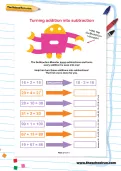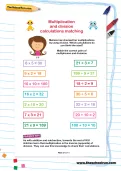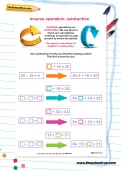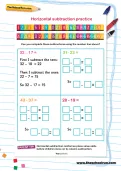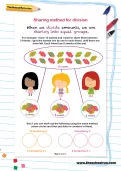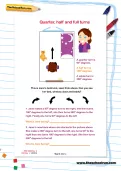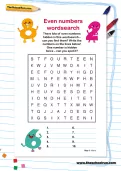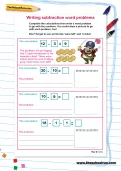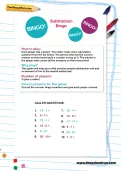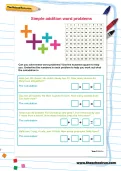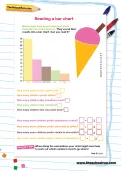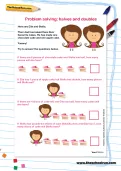Number bonds, partitioning, 2D and 3D shapes and telling the time – all skills children master in KS1 and are tested on in Y2 SATs. Check your child's progress and understanding with our Y2 maths Progress checks, designed to help you spot any gaps in their knowledge so you can support them with extra practice and activities at home.
or
Register to add to your saved resources
The Subtraction Monster loves subtractions and turns every addition he sees into one! Help him turn these additions into subtractions!
or
Register to add to your saved resources
Already a subscriber? to view this content.
Melissa has checked her multiplications by using division. Which calculations do you think she used? Match the correct pairs of multiplication and divisions.
or
Register to add to your saved resources
Already a subscriber? to view this content.
Inverse operations are opposites. We use them to check our calculations, ‘undoing’ an operation to get us back to where we started. The inverse calculation of addition is subtraction. Use subtraction to help you find the missing numbers in these sums.
or
Register to add to your saved resources
Already a subscriber? to view this content.
A fraction represents a part of a whole, with the numerator (top number) indicating how many parts are taken and the denominator (bottom number) showing the total number of equal parts the whole is divided into. Use this fractions worksheet, created by teachers, to help teach your primary school child the basics of fractions.
or
Register to add to your saved resources
Can you complete these subtractions using the number line?
or
Register to add to your saved resources
Already a subscriber? to view this content.
Can you complete these additions using the number line to help you?
or
Register to add to your saved resources
Already a subscriber? to view this content.
When a number is bigger than another number we use the ‘greater than’ sign. When two numbers are the same we use the equals sign. When a number is smaller than another number we use the ‘less than’ sign. Can you add in the correct symbol in the number pairs below?
or
Register to add to your saved resources
Already a subscriber? to view this content.
Can you stick the correct symbol on these pictures? Then find (and draw) something in your house that is: taller than you; shorter than you; the same height as you.
or
Register to add to your saved resources
Already a subscriber? to view this content.
A free division worksheet for Year 2 children, created by an experienced teacher. This fun and visual activity will help your child understand that division is about sharing into equal parts.
or
Register to add to your saved resources
A quarter turn is 90 degrees. A half turn is 180 degrees. A whole turn is 360 degrees. This is Jane’s bedroom, seen from above. Can you see her bed, window, door and teddy? Can you answer these questions about how may degrees she turns?
or
Register to add to your saved resources
Already a subscriber? to view this content.
There are lots of even numbers hidden in this wordsearch – can you find them? One number is hidden twice – can you spot it?
or
Register to add to your saved resources
Complete these calculations then write a subtraction word problem to go with the numbers. You could draw a picture to go with each problem, too! Don’t forget to use words like ‘were left’ and ‘in total’.
or
Register to add to your saved resources
Already a subscriber? to view this content.
Complete these calculations then write a word problem to go with the numbers. You could draw a picture to go with each problem, too! Don’t forget to use words like ‘altogether’ and ‘in total’.
or
Register to add to your saved resources
Already a subscriber? to view this content.
Draw these shapes as if someone has turned them around a little! Use a ruler to help you with the straight lines. If you get stuck, try turning the paper to look at the shape.
or
Register to add to your saved resources
Already a subscriber? to view this content.
Let's play bingo! Each player has a board. The caller reads out a calculation question from the list. The person who has the correct answer on their board puts a counter on top of it. The winner is the player who covers all the numbers on their board first.
or
Register to add to your saved resources
Can you solve these addition word problems? Use the hundred square to help you. Underline the numbers in each problem to help you work out what the calculation is.
or
Register to add to your saved resources
Already a subscriber? to view this content.
Roll three dice and use the three numbers for an addition calculation. (If you only have one die roll that three times instead!) How fast can you finish filling in the whole page? Use a stopwatch and time yourself and record your calculations. On your marks...
or
Register to add to your saved resources
Already a subscriber? to view this content.
Maple class have been finding out about favourite ice-cream flavours. They’ve put their results into a bar chart. Can you read it?
or
Register to add to your saved resources
Already a subscriber? to view this content.
Here are Ella and Stella. Their dad has baked them their favourite cakes. He has made one chocolate cake and one apple cake. Yummy! Try to answer these cake-flavoured questions about halves and doubles.
or
Register to add to your saved resources
Already a subscriber? to view this content.



